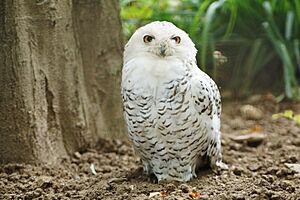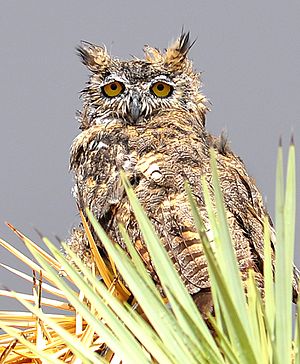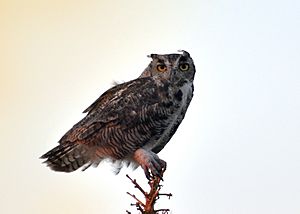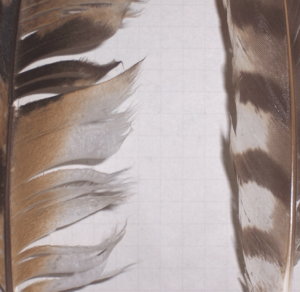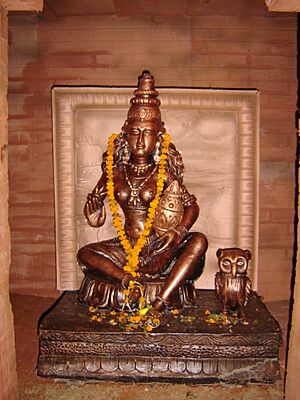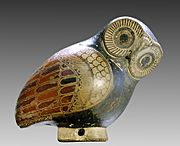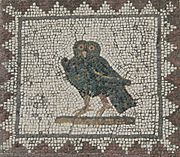Owl facts for kids
Quick facts for kids Owl |
|
|---|---|
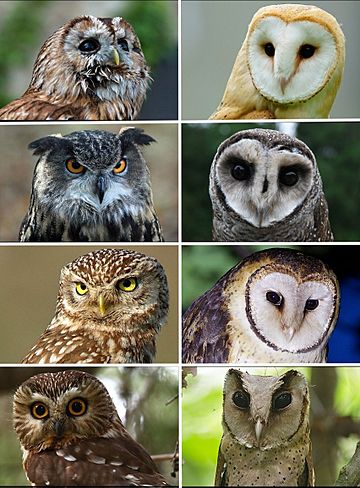 |
|
| Left Strigidae: Tawny owl (Strix aluco), Eurasian eagle-owl (Bubo bubo), Little owl (Athene noctua), Northern saw-whet owl (Aegolius acadicus); Right Tytonidae: Barn owl (Tyto alba), Lesser sooty owl (Tyto multipunctata), Tasmanian masked owl (Tyto novaehollandiae castanops), Sri Lanka bay owl (Phodilus assimilis). | |
| Scientific classification |
|
| Kingdom: | Animalia |
| Phylum: | Chordata |
| Class: | Aves |
| Clade: | Afroaves |
| Order: | Strigiformes Wagler, 1830 |
| Families | |
|
Strigidae |
|
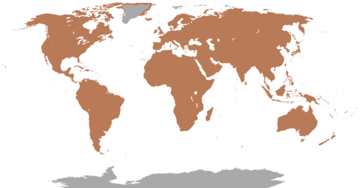 |
|
| Range of the owl, all species. | |
| Synonyms | |
|
Strigidae sensu Sibley & Ahlquist |
|
Owls are amazing birds that belong to the order Strigiformes. There are over 200 different kinds of owls! Most owls live alone and hunt at night. They are known as birds of prey because they hunt other animals for food.
Owls have a special look: they stand upright, have a big, wide head, and can see with both eyes at once (this is called binocular vision). They also have great hearing, sharp talons, and feathers that help them fly silently. Not all owls are nocturnal; for example, the northern hawk-owl hunts during the day.
Owls mainly hunt small mammals, insects, and other birds. Some types of owls are even good at catching fish. You can find owls almost everywhere on Earth, except for the very cold polar ice caps and some faraway islands.
Owls are grouped into two main families: the true (or typical) owls (Strigidae) and the barn-owls (Tytonidae).
Did you know that a group of owls is called a "parliament"?
Contents
Owl Body Features

Owls have large eyes that face forward, just like humans. Their ear holes are also big. They have a hawk-like beak and a flat face. Around their eyes, you'll often see a circle of feathers called a facial disc. These feathers can be moved to help the owl hear sounds better, focusing them towards their ears.
Most birds of prey have eyes on the sides of their heads. But owls' forward-facing eyes give them excellent depth perception. This helps them hunt in low light. Even though their eyes are large, owls cannot move them in their sockets. Instead, they turn their whole head to look around. Owls are also farsighted, meaning they can't see things clearly if they are very close to their eyes. They use special hair-like feathers on their beak and feet to feel their prey. Their vision, especially in the dark, is incredibly good.
Owls can turn their heads and necks as much as 270 degrees! This is because they have 14 neck bones, while humans only have seven. Their bodies are also designed so that turning their head doesn't stop blood flow to their brain.
The smallest owl is the elf owl (Micrathene whitneyi), which weighs about 31 grams (1.1 ounces) and is about 13.5 centimeters (5.3 inches) long. The largest owls are the Eurasian eagle-owl (Bubo bubo) and Blakiston's fish owl (Bubo blakistoni). The biggest females of these species can be 71 cm (28 in) long, have a wingspan of 190 cm (75 in), and weigh 4.2 kg (9.3 lb).
Different owls make different sounds. These calls help owls find mates or tell other owls where they are. Scientists who study birds also use these calls to find and identify different owl species. The facial disc helps owls direct sounds to their ears, and in many species, these discs are placed unevenly for even better sound location.
Most owls have feathers that help them blend in with their surroundings. Some species also have special markings on their faces or heads, like face masks or ear tufts. These markings are more common in owls that live in open areas and might be used to communicate with other owls when it's dark.
Differences Between Male and Female Owls
Sexual dimorphism means there are physical differences between males and females of the same species. Female owls are usually larger than males. This size difference can vary among different owl groups.
One idea is that male owls are smaller so they can be better at finding food. Being able to get more food is helpful during breeding season. In some owl species, the female stays in the nest with the eggs, and the male brings food back. If there isn't much food, the male eats first before feeding the female. Smaller, more agile birds are an important food source for owls. Male burrowing owls, for example, have longer wings than females, even though they are smaller. This suggests that smaller bodies and long wings help them catch prey better.
Another idea is that since female owls often stay in the nest, being larger helps them go longer without food if needed. Larger females might also be better at tearing apart prey to feed their young.
A third idea suggests that larger female owls can choose their mates and might even scare away males they don't like. So, smaller male owls might have been chosen over time because they can escape from females who aren't interested.
How Owls Hunt
All owls are meat-eaters and hunt for their food. They eat insects, small rodents, and rabbits. Some owls are even specially adapted to catch fish. Owls are very skilled hunters in their environments. Since they live all over the world, their hunting skills can vary a bit, but most owls share similar traits.
Silent Flight and Special Feathers
Most owls can fly almost silently and often more slowly than other birds of prey. Since many owls hunt at night, flying without making noise gives them a big advantage. Their prey won't hear them coming! Silent flight isn't as important for owls that hunt during the day, as their prey can usually see them.
Owl feathers are generally larger than average bird feathers. They have special serrated (saw-like) edges on their flight feathers. These edges help reduce air disturbances, making their wing flaps nearly silent. The surface of their flight feathers also has a soft, velvety texture that absorbs sound. These unique features reduce sounds above 2,000 Hz, which is higher than what most of their prey can hear. This means the owl can fly silently to catch prey without being heard, and it can also hear any sounds its prey makes.
The special feathers that allow silent flight mean that barn owl feathers are not waterproof. They can't use the special oils or dust that other birds use to make their feathers waterproof. This means that in wet weather, barn owls can't hunt, which can be a big problem, especially when they have young. Barn owls are sometimes found drowned in water troughs because they land to drink or bathe but can't climb out. Owls also have many soft, downy feathers to help them stay warm since their outer feathers aren't waterproof.
Amazing Vision
An owl's eyesight is very important for hunting at night. Owls are one of the few bird groups that hunt in the dark without using echolocation (like bats do). Owls are known for their very large eyes compared to the size of their skulls. Their eyes are shaped like tubes and are fixed in their sockets. This means they can't move their eyes. Instead, owls turn their heads almost all the way around (about 270 degrees) to see their surroundings. This ability helps them see behind them without moving their body, which keeps them quiet while waiting for prey.
Owls have eyes that are placed very far forward, giving them a wide field of binocular vision. They are farsighted, so they can't focus on things that are just a few centimeters from their eyes. Their large eyes and special vision help them see much better than their prey in the dark.
Incredible Hearing
Owls have special hearing and ear shapes that help them hunt. Some owls have ears placed unevenly on their skull. This asymmetry helps the owl figure out exactly where a sound is coming from. This is especially true for owls that hunt only at night, like barn owls.
With ears at different heights, an owl can tell the direction of a sound by the tiny difference in time it takes for the sound waves to reach each ear. The owl turns its head until the sound reaches both ears at the same time. At that point, it is facing the sound source directly. This time difference can be as small as 30 microseconds!
Behind their ear openings, owls have dense feathers that form a facial ruff. This ruff creates a concave (curved inward) shape that helps cup sounds into their ears. The facial disc also helps direct sound. Their sharply pointed, downward-facing beak also helps by not blocking sound waves from reaching their ears. The owl can even adjust the shape of its facial disc to focus sounds better.
The feather tufts you sometimes see above a great horned owl's head are not its ears. They are just feathers! The real ears are on the sides of its head, in the usual place.
Powerful Talons
While an owl's hearing and vision help it find and chase prey, its talons and beak do the final work. Owls use their talons to crush the skull and body of their prey, killing it. The strength of an owl's talons depends on the size of the owl and its prey. A small burrowing owl has a grip force of about 5 Newtons. A larger barn owl needs 30 Newtons, and one of the biggest owls, the great horned owl, needs over 130 Newtons to release its prey.
An owl's talons are sharp and curved. The barn-owl family (Tytonidae) has inner and middle toes that are about the same length. The true owl family (Strigidae) has an inner toe that is shorter than the middle one. These different toe shapes help them catch the specific prey in their different homes.
Sharp Beak
An owl's beak is short, curved, and points downwards. It's usually hooked at the tip, which is perfect for gripping and tearing prey. Once prey is caught, the owl uses a scissor-like motion with its upper and lower beak to tear tissue and kill. The sharp edges of the beak work together for this. The downward-pointing beak also keeps the owl's vision clear and helps direct sound into its ears.
Natural Camouflage
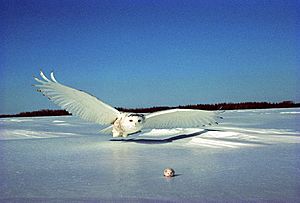
The color of an owl's feathers is very important for helping it blend into its environment. This makes them almost invisible to their prey. Owls usually have colors and patterns that match their surroundings. The barn owl is one exception.
The snowy owl (Bubo scandiacus) is almost pure white with a few black spots, which helps it blend perfectly into snowy areas. The speckled brown feathers of the tawny owl (Strix aluco) help it hide among the trees it prefers. Similarly, the mottled wood-owl (Strix ocellata) has shades of brown, tan, and black, making it nearly invisible in the trees, especially from behind. Often, the only way to spot a hidden owl is by its calls or its brightly colored eyes.
Owl Behavior
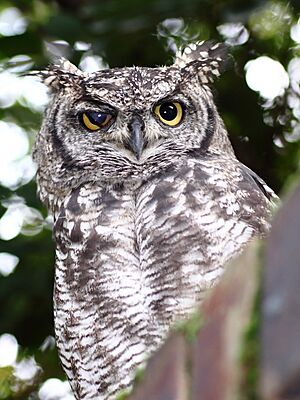
Most owls are nocturnal, meaning they hunt actively in the dark. Some owls are crepuscular, which means they are active during dawn and dusk. An example is the pygmy owl (Glaucidium). A few owls are even active during the day, like the burrowing owl (Speotyto cunicularia) and the short-eared owl (Asio flammeus).
An owl's hunting strategy relies a lot on being quiet and surprising its prey. Owls have at least two ways to achieve this stealth. First, their dull-colored feathers help them become almost invisible in certain conditions. Second, the serrated edges on their wing feathers muffle their wing beats, making their flight almost silent. Some fish-eating owls don't need this silent flight, so they don't have this adaptation.
An owl's sharp beak and strong talons allow it to kill its prey before swallowing it whole (if it's not too big). Scientists can learn a lot about what owls eat by studying their pellets. These are indigestible parts of their prey, like bones, scales, and fur, that owls regurgitate (spit up). Owl pellets are common and easy to study, and are often used in schools to teach about biology and ecology.
Owl Reproduction and Life Cycle
Owl eggs are usually white and almost round. The number of eggs can range from a few to a dozen, depending on the owl species and the season. Most owls lay three or four eggs. In some species, female owls do not stay with the same male for their whole lives. For example, female burrowing owls often travel and find other mates, while the male stays in his territory and mates with other females.
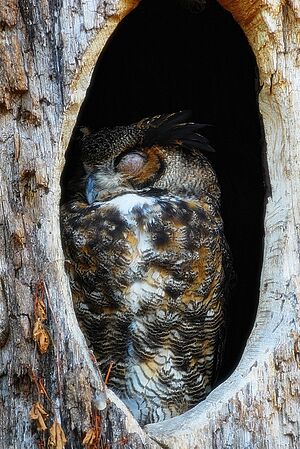
Owls and People
Owls in Stories and Beliefs
Owls appear in many cultures and stories around the world.
- In some Kikuyu traditions in Kenya, owls were thought to bring bad news, like death. This belief is still common today.
- In Mongolia, owls are seen as a good sign. One story says that Genghis Khan was hiding from enemies, and an owl landed in the tree above him. This made his pursuers think no one could be hidden there.
- In modern Japan, owls are considered lucky. People often carry owl charms.
- In ancient Sumerian and Babylonian cultures, the owl was linked to a goddess named Lilith.
- In Western cultures, owls are often seen as symbols of wisdom and being watchful. This idea comes from Ancient Greece, where the city of Athens and its patron goddess, Athena (goddess of wisdom), had the owl as their symbol.
- However, in older European folklore, owls were sometimes seen as a bad omen or a sign of death.
- In Hinduism, an owl is the vahana (mount or vehicle) of the goddess Lakshmi, especially in eastern India. Lakshmi is the goddess of wealth, prosperity, and good luck. So, owls are sometimes seen as symbols of wealth and wisdom.
- In some Native American cultures, owls are often linked to death or spirits of the dead. For example, the Apache and Seminole tribes tell stories to children that owls might take them away if they misbehave at night. The Aztecs and Maya also saw owls as symbols of death.
- The Pawnee tribes saw owls as a symbol of protection from danger.
- The Yakama tribes use an owl as a totem, guiding them on how to manage forests and natural resources.
-
A Roman owl mosaic from Italica, Spain.
-
The Little Owl, painted in 1506 by Albrecht Dürer.
-
Wooden Owls of Natungram, West Bengal, India. These owls are part of an old art form and are linked to the goddess Lakshmi.
Owls for Rodent Control
Owls are natural predators of rodents, so they can help control rodent populations without using harmful chemicals. Farmers and landowners can put up nest boxes for owls on their property. A single family of barn owls can eat more than 3,000 rodents in one nesting season! This helps keep the natural food chain balanced.
Owl Attacks on Humans
While owls and humans usually live peacefully, there have been times when owls have attacked people. For example, in 2013, a man in Scotland was attacked by an owl, likely a large eagle-owl, and was badly hurt. The famous photographer Eric Hosking even lost his left eye trying to photograph a tawny owl.
Protecting Owls
Most owls are protected under an international agreement called CITES (Convention on Illegal Trade in Endangered Species of Wild Fauna and Flora). This means it's illegal to trade them. However, owl poaching (illegal hunting) is still a problem in some areas. In 2008, a large number of dead owls were found in Malaysia, suggesting that illegal hunting might be increasing.
Besides hunting, other dangers to owl populations include:
- Loss of their natural homes
- Pesticides (chemicals used to kill pests)
- Viruses and diseases
- Collisions with vehicles
Owls in Culture
- The owl is the symbol of the Greek goddess Athena (Minerva to the Romans).
- A famous nursery rhyme says: "The wise old owl sat in an oak, the more he heard, the less he spoke."
- "Owl" is a character in the Winnie the Pooh books by A. A. Milne.
- Owls carry the mail in the Harry Potter books by J.K. Rowling.
Related pages
See also
 In Spanish: Rapaces nocturnas para niños
In Spanish: Rapaces nocturnas para niños


